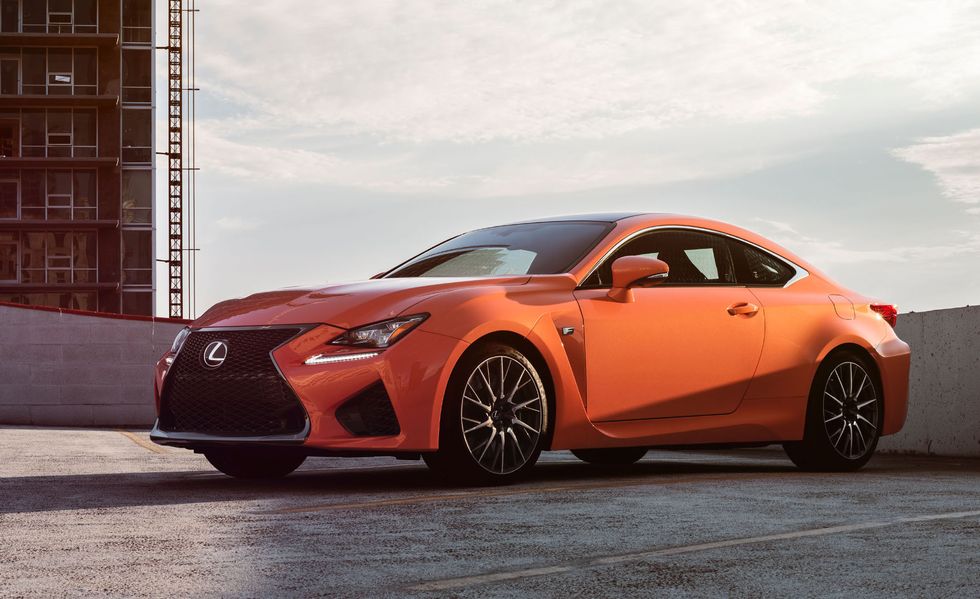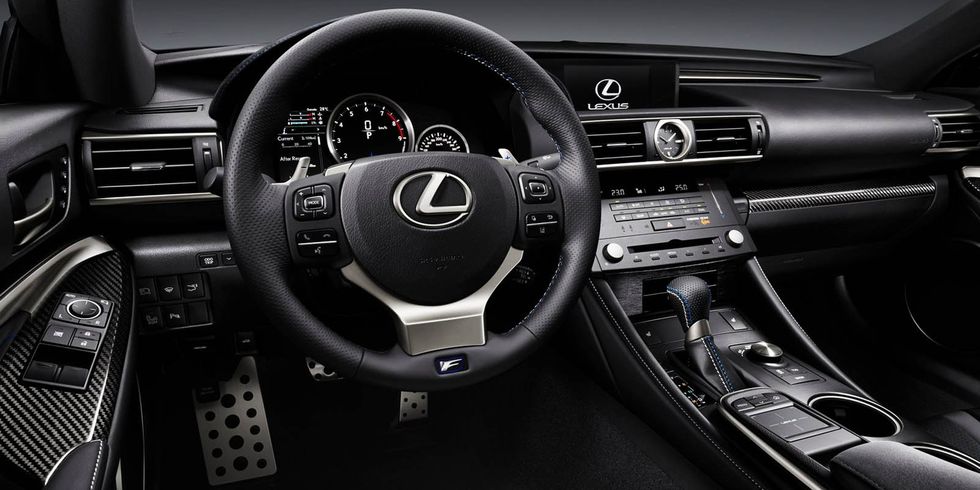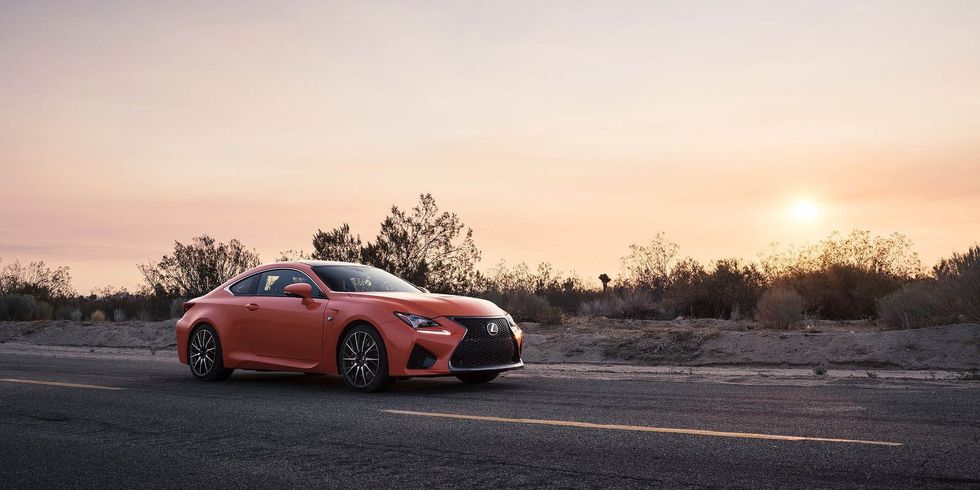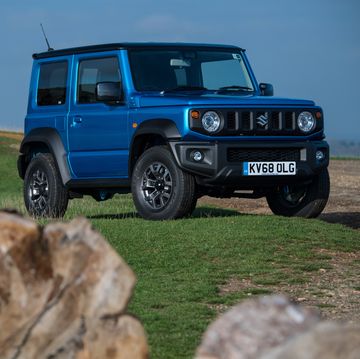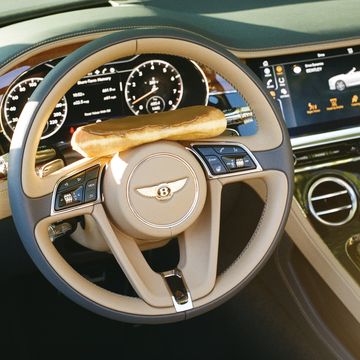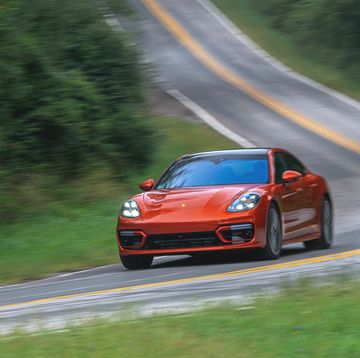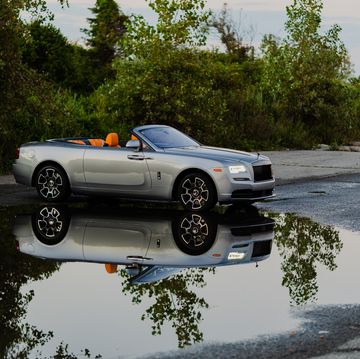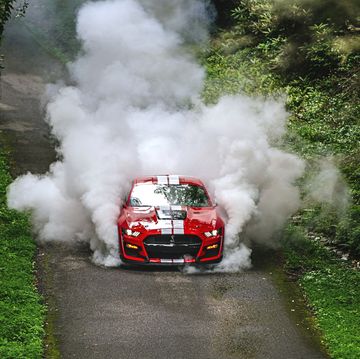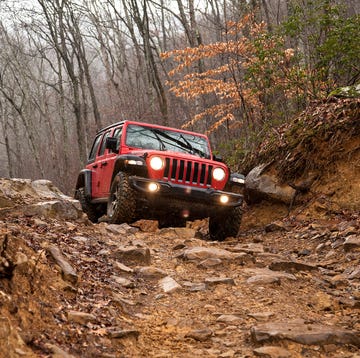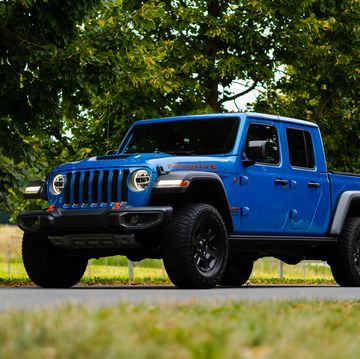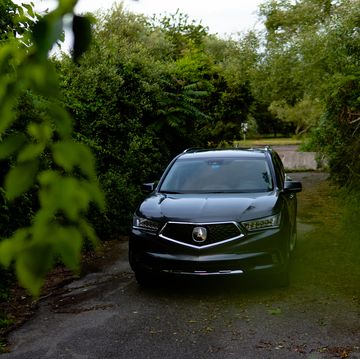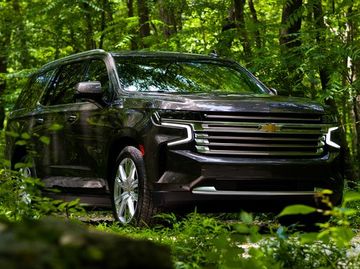Do you miss the Pontiac Trans Am? I certainly do. I watched Knight Rider faithfully as a kid and would endlessly debate my friends about the differences between KITT and KARR. When the new-for-1982 T/A showed up at the Columbus Auto Show, I made sure that I was first in line to see it. Don't get me wrong; I liked the Camaro Z28, and I was kinda-sorta okay with the Mustang GT 5.0. But my young heart really only had room for one true love, and it wore a Pontiac badge. The Trans Am combined first-rate performance with over-the-top styling. It was a man's car, because no woman would be stupid or goofy enough to drive anything that looked like a Trans Am.
My first experience with the Lexus RC F, which occurred during our testing for PCOTY 2015, suggested that the outrageous-looking coupe might be a candidate for that Trans-Am-shaped hole in my heart. It certainly had the right visual package. The base RC coupe is anonymously striking the same way a four-cylinder '82 Firebird was, but the F-model adds just the right amount of wrong, so to speak.
That Predator grille: ridiculous and unnecessary. The headlights, unique to the RC F: ugly but amazing at the same time thanks to the triple-rectangle reflectors. Let's not forget the vented front fenders, the flared-out hindquarters, and the extra-tall hood that announces the presence of a V8 the same way the "power bulge" in the hood of the '82 Trans Am let the chump next to you at a stoplight know it was time to put on the right turn signal or take a serious ass-whipping.
The stage was set for a hot bromance, but as is often the case in these situations, a few external factors intervened to cool things down. During the fast-road portion of our drive, I was switching back and forth between the RC F and the Jaguar F-Type R coupe. The Jag has nearly a 100-hp advantage over the Lexus, and it also displays a joie de vivre that isn't immediately apparent in any Toyota product whatsoever. In that context, the RC F didn't exactly shine.
Once we got to the track, I didn't have enough time to master the various electronic configurations necessary to let the Lexus off the stability-control leash. As a result, I was thoroughly frustrated by the caliper-chomping, fun-killing interventions that occurred almost continually all the way around the Motown Mile.
The story would have ended there except for the fact that a friend who works for Lexus brought an RC F to a race I was running at New Jersey Motorsports Park last year, and my girlfriend absolutely fell in love with the car. She's been bugging me ever since to give the big coupe a second chance, and now that we're married it seems reasonable to pay attention to her when she asks for something. As fate would have it, Lexus had a Molten Orange RC F available last weekend, and I had a long drive to an open-lapping Saturday scheduled. It was a no-brainer to request the car to see if 900 road miles and 50 laps of Summit Point's Shenandoah racetrack could rekindle this stalled love affair.
(Between me and the RC F, not between me and my wife.)
Every May since 2006, I've headed to Shenandoah to drive with the great people at TrackDAZE. The cars I've taken there have run the gamut from a Camry SE to a C7 Corvette Z51, with various Mustangs, Porsches, and even a Volvo in the mix as well. Over the past decade, I've probably run more than 25 different cars there. Although the track is notoriously unforgiving of mistakes thanks to a series of concrete walls that are rarely more than 15 feet off the racing surface, Shenandoah is really good at uncovering flaws in street cars thanks to its hectic mix of slow turns, fast sweepers, elevation changes, and one infamous "ski jump" on the back straight.
My schedule for the weekend was almost too tight to be practical; I planned to leave Columbus, Ohio at 11:00 on Friday night, arrive at Summit Point in time for the instructor's morning meeting, drive all day on track, then return to Columbus after dinner. By the time I got into the pumpkin-orange coupe to make the drive down, I was already tired from a long work day and an evening spent running around after my seven-year-old son.
The day before, I'd had lunch and a quick drive with a friend who noted that the RC F "is just like any other Lexus until the tach hits five grand." He's a GX470 owner, and I think he's employing a bit of hyperbole here, because the RC certainly has very little to do with the GX470, or the best-selling RX350, at any engine or road speed. With that said, there are some fundamental "Lexus values" that were an integral part of the original 1990-model-year LS400, like a library-quiet interior, a smooth ride, a brilliant stereo, and uncompromising build quality.
All of those basic values and/or virtues are also present in the RC F. The door glass is thick, and it seals perfectly despite being frameless. As long as the rotary drive-mode controller in the center console is set to "Normal," the car rides very, very well on all road surfaces. The optional Mark Levinson stereo can rattle your molars out, but nothing in the car will be rattling in sympathy with said teeth because there isn't a single panel or fitting in the RC F that is loose or sloppy in any way.
The automotive press has been quick to point out that the Lexus is considerably heavier than the equivalent BMW or Mercedes-Benz, even if you spring for the $5500 carbon-fiber package that also includes a tricky rear differential. I think it's just as important to point out that you get something in exchange for that extra weight, namely bank-vault solidity at all speeds and in all conditions. If you'd rather have a lighter sporting coupe that doesn't feel quite as much like it's milled from the proverbial single piece of steel, that's your choice. . . but at that point, you might as well go the rest of the way and get a Corvette.
The drive from Columbus to Summit Point starts with a 200-mile freeway slog before switching over to old Route 40 for a foggy run up and down a series of mountains and then finishing with 60-plus miles of twisty two-lanes. In all of these situations, the RC F is utterly unflappable. The radar cruise control is a great tool for long drives on mostly empty roads; it stays vigilant even when you're distracted. On crowded freeways, unfortunately, even the smallest of the three different following-distance settings encourages other drivers to cut right in front of you, at which point the Lexus will haul on the brakes to the immense surprise of anybody in your rearview mirror.
My primary gripe with the RC F as a freeway cruiser has to do with the eight-speed automatic transmission. It's a conventional torque-converter-and-planetary gears affair, although the torque converter locks pretty much all the time in all but first gear. Presumably the internal clutches are strong enough to handle shifts on a locked converter, because the IS-F used the same system and has generally held up very well.
The problem is that in an effort to maximize fuel economy, which averaged 19.7 mpg during my test, the RC F will get into seventh or eighth gear as soon as humanly possible and stay there. The kind of mild throttle pressure that usually summons a downshift in modern DSG-equipped vehicles doesn't produce any action whatsoever in the Lexus. You have to mash the throttle, at which point there's a half-second pause before fifth or fourth gear arrives, the 467-hp V8 revs up, and you are outta there. Until you get used to this, you'll find yourself disappointed by the RC F's power. It's not the engine; it's the transmission.
Once I was on Maryland Route 51 and hustling, however, the automatic became significantly more cooperative. This is a very quick car in a straight line, although some of its rivals, like the BMW M4, can post slightly better numbers. And it's even better on a curvy back road than the numbers suggest. The massive Brembo calipers are stout even with the factory pads and fluid, and the five-liter pushes to the redline in every gear before the next shift arrives with a precise "slam" that you don't get in any other torque-converter automatic. After 50 miles of full throttle and full brake at a pace that can best be described as "hurried," the RC F was ready for another 50. I was able to beat my own schedule plans by enough to get a two-hour nap before the driver's meeting at Summit Point.
As a track car, the Lexus has some distinct disadvantages. There's that weight we talked about before. Down Shenandoah's back straight, a C7 Vette can pick up about three car lengths on the RC F. Even a previous-generation E90 V8 M3 can gap it a tiny bit. It doesn't help that the transmission can be a bit imprecise with the upshift timing, so when you have it in manual mode, it's best to pull the right-side paddle just a fraction of a second before you think you'll really need the shift. This is made more difficult because the very tricky and cool TFT dashboard tends to wash out a bit in direct West Virginia sunlight, particularly when you're wearing polarized glasses. You have to shift on the sound of the thing because the tach needle is hard to find.
On the plus side, when you're in the braking zone, you can simply click the left paddle a few times and the RC F will delay the downshift until it's safe for the engine. Best of all, the paddles are mounted on the wheel, not the steering column.
Shenandoah is chock-full of tight turns, and the optional Torque Vectoring Differential is a great help here in fighting understeer. In situations where most cars would wash the front end, a little power goes a long way to keep the RC F neutral. It's been a long time since I drove a street car of this size that was this averse to pushing the nose. Maybe never. There's a screen in the RC F's display that shows you what the diff is doing, but of course, it's mostly invisible when you're on track and shouldn't be looking at it anyway.
Overall grip levels are good, better than that E90 M3 but a little short of a C7 'Vette. There are few cars that can drop the RC F around a middle-radius turn on a racetrack. But it's at corner exit that the Lexus will steal your heart. You see, most of the cars in this class are going turbo, which means that you're going to be faced with a flat torque curve as you unwind the steering and accelerate. With the BMW M4, that means that there's always a chance that the next bit of throttle you put on will spin the back wheels (if you have ESC off) or cause a stability-control event that will steal your speed (if ESC is on). With the Lexus, however, the naturally aspirated thrust is totally predictable and the drive-by-wire throttle control is almost hilariously precise. This means that you can get on the throttle nice and early and ramp up power very quickly. Almost nothing with four seats can beat the RC F out of a corner.
I tested that theory in my third lapping session of the day. The track started off dry but the rain came pretty quickly about 10 minutes in. I was dicing with an instructor-caliber driver in a new-generation M4. As long as the track was dry, I couldn't close the gap, but the minute it was even the slightest bit shiny I saw that back end start wobbling every time he passed the apex. I started making up one car length per turn on the way out and before I knew it he was a small dot in the mirror. That's something the stat sheet can't tell you: Can you trust your throttle application on a wet surface? With the Lexus, the answer is "hell yes."
No test at Shendandoah is complete without mentioning the "ski jump." The RC F approaches this jump at well over 120 mph and goes four-wheels-up for half a second before touching down with what I have to say is the most luxurious body control I've ever experienced at that track. You can get on the brakes immediately if you want to, because there's no secondary bounce from the chassis. This is where the Lexus has it all over Mustangs and Corvettes, by the way. The same is true for the entrance to the concrete Carousel; you can enter at maybe 5mph more than you can in a Vette because the suspension control is so absolute.
Even with two extra passengers in the car, the RC F is a true thrill ride around a racetrack. True, the ESC is never fully off, but this is an $81,000 car and maybe it's worth it to have just that very last line of defense available between you and the concrete walls. It's possible to get the car pretty sideways, even in the wet, before the systems call time on the whole endeavor.
At the end of the day, I reviewed my video to get some laptimes. I don't like to compare times set across multiple months or years with widely varying track temperatures and whatnot, but I feel comfortable saying that the RC F neatly splits the lap-time gap between a C7 Z51 and a Mustang 5.0. With a proper manual transmission, the time would drop a bit, and the fun would go up. I'd be surprised if Lexus ever supplied the car that way, but if they did, that would elevate the RC F into the Pantheon of the all-time great dual-purpose daily-driver/track-car combinations.
I'm glad the RC F and I got a second chance. This time, the romance is definitely on. It's not quite as hardcore as the German competition, but the Trans Am was never quite a match for the IROC-Z around a racetrack, and I didn't care about that either. The Lexus is very good on a track and simply brilliant away from it. Call it the finest Japanese ponycar in history, and one that deserves a second look from you as well.
Jack Baruth is a writer and competitor who has earned podiums in more than fifteen different classes and sanctions of automotive and cycling competition, in both amateur and professional capacities, as well as an enthusiastic hobbyist musician and audiophile who owns hundreds of musical instruments and audio systems. His work has appeared in Bicycling, Cycle World, Road & Track, WIRED, Wheels Weekly, EVO Malaysia, Esquire, and many other publications. His original design for a guitar, the Melody Burner, has been played by Billy Gibbons, Sheryl Crow, and others.
